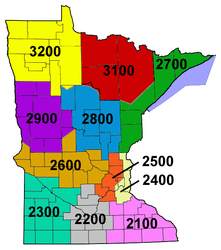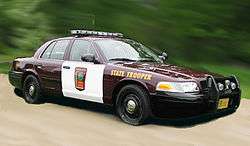Minnesota State Patrol
| Minnesota State Patrol | |
|---|---|
| Abbreviation | MSP |
|
Patch of the Minnesota State Patrol | |
| Agency overview | |
| Formed | 1929 |
| Employees | 821 (as of 2004)[1] |
| Legal personality | Governmental: Government agency |
| Jurisdictional structure | |
| Operations jurisdiction* | State of Minnesota, United States |
 | |
| Minnesota State Patrol Districts | |
| Size | 87,014 square miles (225,370 km2) |
| Population | 5,197,621 (2007 est.)[2] |
| General nature | |
| Operational structure | |
| Headquarters | St. Paul, Minnesota |
| Troopers | 544 (as of 2004)[3] |
| Civilians | 277 (as of 2004)[4] |
| Agency executive | Colonel Matthew C Langer[5] |
| Parent agency | Minnesota Department of Public Safety |
| Patrol Districts | 11 |
| Facilities | |
| Stations | 61 |
| Website | |
| Minnesota State Patrol | |
| Footnotes | |
| * Divisional agency: Division of the country, over which the agency has usual operational jurisdiction. | |
The Minnesota State Patrol is the statewide police force in the state of Minnesota. While the State Patrol concentrates primarily on traffic enforcement and highway safety it also has a statewide law enforcement role. . Troopers are also involved with accident reconstruction and commercial vehicle enforcement. The State Patrol capitol security division also handles the security for the Minnesota State Capitol grounds and the governor. Additionally, the State Patrol maintains a K-9 unit that focuses on drug enforcement interdiction, as well as a Special Response Team (SRT), that operates like a traditional SWAT Team.
History

The Minnesota Highway Patrol was created in 1929 when Charles M. Babcock, the Commissioner of Highways, appointed Earl Brown, Sheriff of Hennepin County, as Chief of the Highway Patrol. On July 1, 1929, Chief Brown appointed 8 officers.
The first training school was held January 18 to April 1, 1930. This school graduated the first 35 members of the Minnesota Highway Patrol. [6]
In 1974 the Highway Patrol was reorganized and the official name was changed to the “Minnesota State Patrol.” [7]
The patch
The patch worn by members of the Minnesota State Patrol evolved from "The Great Seal" which is placed on all official state documents. The design is similar to the territorial seal which was used from 1849 until the adoption of the State Seal in 1858. It depicts a man in the foreground plowing, while a Native American is riding into the sunset in the background. The picture on the seal is a scene near St. Anthony Falls, located in Minneapolis, Minnesota. The Motto "l’Etoile Du Nord" was selected by the first governor, Henry H. Sibley, which translated is "The North Star", thereby making Minnesota, "The North Star State".[8]
Organization
- District 2000 - St. Paul (Headquarters)
- District 2100 - Rochester
- District 2200 - Mankato
- District 2300 - Marshall
- District 2400 - Oakdale
- District 2500 - Golden Valley
- District 2600 - St. Cloud
- District 2700 - Duluth
- District 2800 - Brainerd
- District 2900 - Detroit Lakes
- District 3100 - Virginia
- District 3200 - Thief River Falls
- District 4600 - Capitol Security / Executive Protection
- District 4700 - Statewide scales and Commercial Vehicle Services.
- Flight Section - Statewide flight service area.
- Investigative Services - Statewide vehicle crimes and accident reconstruction.
- Metro Communications - St. Paul / Minneapolis Metro Radio
- Training Academy- Statewide training and recruitment.
Fallen officers
Since the establishment of the Minnesota State Patrol, eight officers have died while on duty.[9]
See also
References
- ↑ USDOJ Statistics
- ↑ 2007 Population Estimates, U.S. Census Bureau
- ↑ USDOJ Statistics
- ↑ USDOJ Statistics
- ↑ https://dps.mn.gov/divisions/ooc/news-releases/Pages/Commissioner-Dohman-Appoints-Kelly-Director-of-Hokend-Security-and-Emergency-Management,-Langer-Chief-of-the-Minnesota-Stat.aspx
- ↑ The Minnesota State Patrol Trooper's Association site
- ↑
- ↑ The Minnesota State Patrol site
- ↑ The Officer Down Memorial Page
